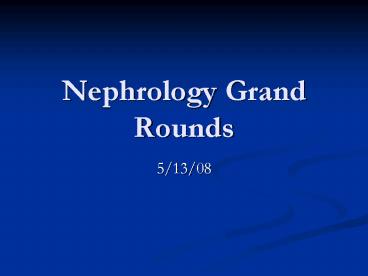Nephrology Grand Rounds - PowerPoint PPT Presentation
1 / 13
Title:
Nephrology Grand Rounds
Description:
Nephrology Grand Rounds. 5/13/08. Refractory Hyperparathyroidism. Brad Weaver ... Polyclonal cell proliferation (diffuse hyperplasia) summative effect of each ... – PowerPoint PPT presentation
Number of Views:421
Avg rating:3.0/5.0
Title: Nephrology Grand Rounds
1
Nephrology Grand Rounds
- 5/13/08
2
(No Transcript)
3
Refractory Hyperparathyroidism
- Brad Weaver
4
Causes of refractory HPTH
- Inadequate therapy
- Persistent hyperphosphatemia
- Acquired abnormalities of parathyroid gland
- Polyclonal cell proliferation (diffuse
hyperplasia) summative effect of each cell
having a nonsuppressible basal secretion of PTH - Monoclonal cell proliferation can lead to
adenomatous cells that do not respond to
appropriate feedback
5
General indications for parathyroidectomy
- Symptomatic patients with elevated and
nonsuppressible iPTH (usually gt800) - Hyperparathyroid bone disease diagnosed by
radiographical evidence or bone biopsy - Extensive extraskeletal calcifications or
calciphylaxis - Refractory pruritis
- Unexplained myopathy
- Severe hypercalcemia (mainly seen in primary HPTH)
6
Effects of parathyroidectomy
7
Effects cont.
- Parathyroidectomy may have beneficial effects on
humoral immunity - Prospective study 1999 34 dialysis patients
received parathyroidectomy for 2HPTH. - At 12 months there were significant increases in
serum levels of IgG, IgM, IgA, C3, C4, and CH50 - Nutrional status also improved as measured by
significant increases in albumin and hematocrit
Am J Surg 1999 Oct178(4)332-6.
8
VA Study 2004 U. of Washington
- Observational matched cohort study of 4558
dialysis patients undergoing parathyroidectomy
vs. 4558 matched controls - Higher 30 day mortality in parathyroidectomy
group 3.1 vs. 1.2 in controls - Long term survival better in parathyroidectomy
group 53 vs. 47 months - Survival curves crossed at 587 days s/p surgery
Kidney Int 2004 Nov66(5)2010-6
9
Parathyroidectomy and transplant
- What to do with a patient with refractory
hyperparathyroidism on transplant list? - Most cases (approximately 96) of HPT resolve
after transplant - HPT that does not resolve may cause increased
risk to the renal graft and may cause
hypertension - However, parathyroidectomy in transplant patients
carries a small risk of sudden deterioration of
renal graft function
10
Surgical considerations
- In primary HPTH, nuclear medicine scans
(technetium-99m-sestamibi or I-123 SPECT) are
used to detect location of glands prior to
surgery - Unknown if useful in 2HPT due to renal failure
- Total parathyroidectomy with autotransplantation
is the most common technique - Reoperation rates for persistent HPT are 6-14
11
Hungry bone syndrome
- Severe hypocalcemia following parathyroidectomy
in spite of normal or elevated PTH levels - Sudden decrease in PTH disrupts bone equilibrium
of resorption vs. formation - Most common in patients with severe preexisting
bone disease - Occurred in 20 of 148 dialysis patients
undergoing parathyroidectomy in one series
Kidney Int Suppl 2003 Jun(85)S97-100
12
Hungry bone syndrome cont.
- Hypocalcemia
- Nadirs 2-4 days post op
- If tetany and seizures occur, they can increase
fracture risk - Sudden heart failure has been attributed to
hypocalcemia - Hypophosphatemia and hypomagnesemia
- Mainly seen in primary HPTH
- Hyperkalemia
- Occurs in 80 of dialysis patients post-op
13
Treatment
- Oral calcium 2 to 4 g per day
- IV calcium for symptomatic hypocalcemia or Ca lt
7.5 1 amp of calcium gluconate instilled over
10 to 20 minutes followed by maintenance drip - Vitamin D supplementation calcitriol
- Hemodialysis use high calcium bath (3.5 mEq/L
Ca) - Peritoneal dialysis add 1 to 3 amps of calcium
gluconate to each bag of dialysate































